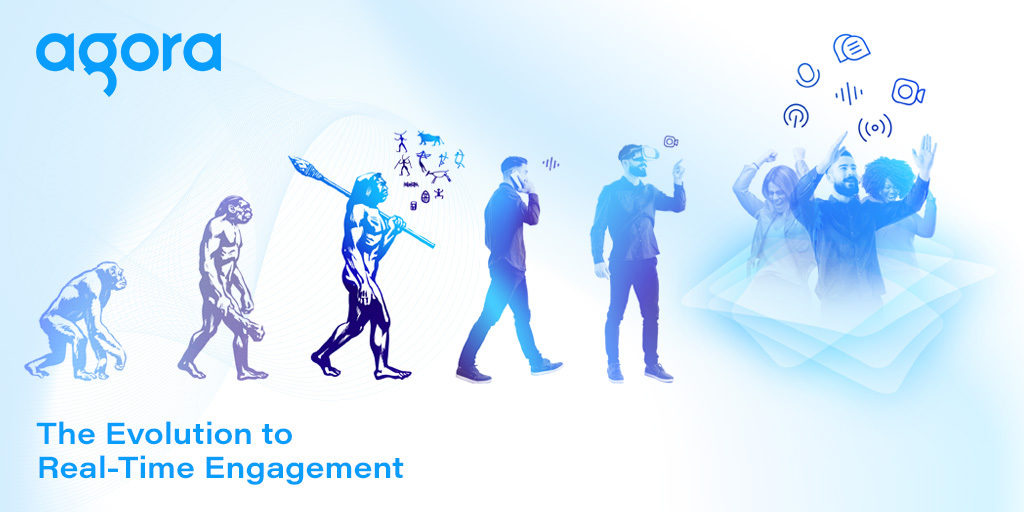
The Evolution to Real-Time Engagement
Ask yourself: How often do you use your mobile device to make a phone call? If you’re like us, your device is really a gateway to other apps—news, text, shopping, games, etc—while your phone app is a center for spam and the occasional call for takeout. The Age of Communication through landlines is long over. Just as you can use stones for tools at need, you may still call someone on your phone, but it’s probably not your first choice for communication.
Real-Time Communications as a Springboard to Real-Time Engagement
The more modern version of landlines is VoIP and live video, falling under the category of Real-Time Communications (RTC). These network-connected, near-instant ways to interact have made it possible for humans to engage over vast distances and in real time.
In particular, live video is a game changer. While voice chat allows you to hear someone’s tone of voice, and messaging includes expressive visuals, the sheer density of information that comes across on live video chat makes it the clear winner for engagement. On a video call, you not only hear the other person’s words and tone of voice, but you can see their expressions and body language.
While voice and video chatting have taken the world by storm, they have primarily been available in standalone apps like Skype, Zoom, FaceTime and Google Meet, dedicated specifically to communication and limited to point-to-point connections. This makes these tools more of a utility than an immersive experience but sets the stage for RTC technologies to springboard us into Real-Time Engagement (RTE).
The Age of Real-Time Engagement Starts with Shared Context
To have a truly engaging experience requires shared context. The ability to share the same space, hear the same sounds, see the same sights—these are the details that build bonds.
Now that consumers are comfortable using video, they increasingly crave this shared context and expect to have video engagement directly inside the apps they are already using.
Especially in the time of COVID-19 and extended periods of shelter-in-place, apps that leverage live interaction are growing dramatically as they keep people socially connected and meet business needs. Social networking app MeetMe makes dating fun by adding live video streaming, and a new generation of workforce collaboration tools like Pragli and Airmeet are facilitating creative brainstorming and networking opportunities that were previously available only in person.
Contextual engagement has also reached other traditional industries like healthcare and retail. Talkspace has created a virtual space for therapists to talk to patients, and retail companies like Lisa and Popshop offer live-stream shopping experiences that boost customer engagement and conversion.
All of these companies have fundamentally integrated shared context into their apps and are at the leading edge of the Age of Real-Time Engagement.
What is Real-Time Engagement?
Real-Time Engagement (RTE) is in its infancy and shared human context is just the first element we see in the triad at the core of our RTE vision:
- Shared Context
- Interactivity at any Scale
- Ubiquity
Together, these three pillars set the stage for the future of killer applications, where human interactions can mingle with digital environments, chats can be intimate or scale to millions of people and everyone has access from every device, anywhere around the globe.

Shared Context in Real-Time Engagement
We’ve discussed shared context in terms of human interactions, but it also extends to human-to-technology interactions. Consider a virtual classroom or business meeting where participants use a whiteboard—they are engaging with each other as well as the whiteboard.
As RTE matures, we will increasingly see people interact with one another as well as with digital content in virtual environments. VirBELA is an example of a metaverse where people engage in a virtual shared campus. Imagine a metaverse applied to live sports, music concerts and game shows. You could play tennis with your favorite pro, go backstage at a concert with your best friend or compete on Jeopardy—all from the comfort of your own home.
The experiences you have in real life (IRL) can be replicated and even enhanced in the virtual world. For instance, the concert experience can include the backstage pass, the concert itself, a pre-concert meet and greet, access to the stage and purchasing of swag—all within the virtual concert venue. Do you think this will exist in the far future? In fact, VRJAM has created a platform that combines virtual reality with video streaming to allow artists and fans to experience performances inside live, immersive worlds.
Interactivity at any Scale in Real-Time Engagement
The second principle of RTE is Interactivity at any Scale. This is the concept of supporting a wide range of engagement, from one-on-one and small group chats to events that engage hundreds of thousands or millions of people at the same time.
Today, in the US, social media influencers post on-demand video content and hold live events that can reach millions. Globally, influencers livestream their lives for hours every day. This broad reach is only one part of the equation. When we add the first principle of RTE—shared context—now we’re talking about interactive live streaming, where the audience can be true participants in the event.
Worldwide, we are seeing an increase in demand for audience-to-host, host-to-host, and co-watching experiences provided by companies such as Scener. We believe this is just the beginning of a coming transformation in the entertainment industry.
Ubiquity in Real-Time Engagement
The last part of the RTE equation is ubiquity. Here, we focus on allowing everyone to interact with anyone, in any app, anytime and anywhere. Whether you’re in your car, in the kitchen or in a park, you should be able to use any device to engage with your favorite apps.
This drive towards convenient access to digital content is already apparent in the popularity of voice-activated home systems and smart appliances. As demand for richer engagement increases, we are seeing live video embedded in everything from TVs and smart watches to self-driving robots and refrigerators. We are fast approaching a world where the interactivity you crave will be seamlessly available on any screen as you move through your day.

Build the Future Now on an RTE Platform
Building interactive apps that can reach millions of people on any device may seem like an out-of-reach dream. RTC-based technology solutions only work well for one-on-one or small group chats, while CDN-based technologies that can scale to hundreds of thousands or millions of people make compromises on latency, effectively removing the possibility of any interaction between hosts and participants.
To replicate IRL experiences that truly deliver on Real-Time Engagement—shared context, interactive at scale, ubiquity—requires a real-time global network with sub-second latency.
In 2014 Agora started planning for the reality of Real-Time Engagement. We designed and built SD-RTN™, an intelligent virtual overlay network, that delivers sub-second latency across the globe and is hyper scalable from one to millions of concurrent users. We also engineered and optimized audio and video algorithms for a wide variety of use cases to ensure the best results even in poor network conditions. Last but not least, we make it easy for developers to adopt RTE technology by supporting all popular development platforms. This means that developers can create apps that are compatible for most devices—from mobile phones, tablets and personal computers to smart TVs, wearables, VR headsets and smart appliances.
We believe that the Age of Real-Time Engagement is here. Whether you’re building a gaming app that brings friends together in the same virtual space, a social platform to interact with millions of people, an AR medical engineering solution or an AI-based sales tool, the Agora Real-Time Engagement Platform is ready for you.
Now, ask yourself: Are you ready to build the future? If so, sign up for free or simply talk to us. We are dedicated to helping you turn ideas into reality.
Want to build Real-Time Engagement apps?
Get started with 10,000 free minutes today!
If you have questions, please call us at 408-879-5885. We’d be happy to help you add voice or video chat, streaming and messaging into your apps.